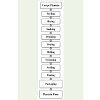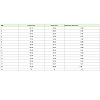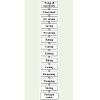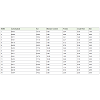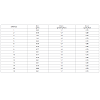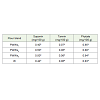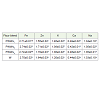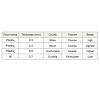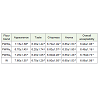Research Article
Quality Characteristics of Cookies Produced from Composite Flours of Unripe Plantain, Wheat andWatermelon Seed
Oludumila Omolara Racheal* and Adetimehin Abosede Margaret
Department of Food Science and Technology, Federal University of Technology, Akure, Ondo State, Nigeria
Corresponding author: Oludumila Omolara Racheal, Department of Food Science and Technology, Federal University ofTechnology, Akure, Ondo State, Nigeria; E-mail: heniolarh@yahoo.com
Citation: Racheal OO, Margaret AA. Quality Characteristics of Cookies Produced from Composite Flours of Unripe Plantain, Wheat and Watermelon Seed. Indian J Nutri. 2016;2(2): 117.
Copyright © 2016 Racheal OO, et al. This is an open access article distributed under the Creative Commons Attribution License, which permits unrestricted use, distribution, and reproduction in any medium, provided the original work is properly cited.
Indian Journal of Nutrition | ISSN: 2395-2326 | Volume: 2, Issue: 2
17/01/2016; Accepted: 01/02/2016; Published: 06/02/2016
Abstract
This study was carried out to evaluate the quality and acceptability of cookies produced from the flour blends using cookies prepared from wheat flour as control. Acceptability of the produced cookies and chemical properties of the flour blends were determined. Response Surface Methodology was used to develop the mixing ratio and also model the protein and crude fibre responses. Results showed that the cookies prepared from the blend of plantain, wheat and watermelon flour 71.48/18.52/10.00 had higher crude fibre content (4.01%) than wheat flour (1.69 %) and significantly different protein content (2.44%) than that produced from wheat flour (6.81%). The Iron (Fe) content of the cookies produced from the blend 72.08/22.93/5.00 was 2.71% which was similarto that of wheat (2.70 %) and the Phosphorus (P) content of the cookies prepared from the flour blend 72.08/22.93/5.00 (1.46 %) was significantly different from the cookies produced from wheat (1.20%). The overall acceptability of the cookies produced from the blend 72.08/22.93/5.00 was 6.98 while that of wheat flour was also 6.98 without any significant difference. The study thus shows that cookies of produced from plantain, wheat and watermelon seed blend 72.08/22.93/5.00 had the highest acceptability in terms of taste, texture, crispness, aroma and appearance.
Keywords: RSM; Chemical Properties; Acceptability; Optimization
Introduction
Cookies are one of the confectionary food product consumedin Nigeria especially among children. It is ready to eat, convenientand inexpensive food product, containing digestive and dietaryprinciples of vital importance [1]. In Nigeria, reliance on wheat flourin the pastry and bakery industries has over the years restricted theuse of other cereals and tuber crops available to domestic use. Inrecent years, government has through intensive collaboration withresearch institutes encouraged the use of composite flours in theproduction of bread and related food products such as biscuit. Thisinitiative has enhanced the use of flours from cassava, sweet potato,bread-fruit, plantains and other under-utilized crops that are goodsources of flour. The adoption of these locally produced flours in the bakery industry will increase the utilization of indigenous cropscultivated in Nigeria and also lower the cost of bakery products[2].
Plantains are highly perishable staple foods and according toFAO [3], over 2.3 million metric tons of plantains are produced inNigeria annually. However, about 35 % - 60 % post-harvest losseshad been reported and attributed to lack of storage facilities andinappropriate technologies for food processing [4]. Nutritionally,plantain (Musa paradisca) constitute a rich energy source withcarbohydrate accounting for 22 and 32% of the fruit weight forbanana and plantain respectively and also rich in vitamins A, B6, C,dietary fibre, iron potassium and calcium [5]. Plantain is known tobe a highly perishable food which is largely produced in Nigeria but underutilized and the fact that Nigeria does not grow wheat and reliesheavily on importation of the commodity justifies the continuedsearch for flour composites for local use [6].
Watermelon seed is one of the major under-utilized fruits grownin the warmer part of the world. The juice or pulp from watermelonis used for human consumption, while rind and seeds are major solidwastes. The seeds can be cooked and dried and served as snacks andfermented for use as a flavour enhancer in gravies and soups [7].Watermelon seed is a rich source of dietary fiber which is desired indeveloping functional foods and is an underutilized fruit by-productand is reported to be high in protein and has excellent functionalproperties and has been found to be effective in baking [8].
Response Surface Methodology (RSM) is a collection ofstatistical and mathematical techniques by analyzing the responsesurface contour to find optimal process parameters and usingmultiple quadratic regression equation to fit between the factorsand the response function. RSM is a useful technology in developingprocesses and optimizing their performance [9]. To develop or tooptimize processes, many companies use statistical approaches, suchas response surface methodology (RSM), in their research department in order to achieve the best combination of factors that will render thebest characteristic of a product and or process response [10].
Materials and Methods
Sample Collection
The unripe plantain, watermelon pods, wheat flour bakingingredients and packaging materials were obtained from ErekesanMarket. All reagents used were of analytical grades and were obtainedfrom Pascal Laboratories, Akure, Ondo State, Nigeria.
Sample preparation
Preparation of Unripe Plantain Flour: Matured unripe plantainfruits were washed under running water hand peeled and the edibleportion (pulp) was sliced with a stainless knife into 2.5 cm thickslices (6.0x4.0 cm). The slices were immersed in 0.25 g L-1 sodiummetabisulphite at 30 °C for 10 min. The slices were dried at 60 °C ina cabinet dryer for 24 h and then ground into flour using an attritionmill. The flour samples were passed through a 0.45 mm mesh sizesieve to obtain the flour and poured in plastic containers with lids andstored at room temperature (25 °C) for further analysis according toAkubor and Ukwuru [11]. The procedure is shown in Figure 1.
Preparation of Watermelon Seed Flour: Watermelon pods werewashed, cut into slices and the seeds were extracted, washed, drainedand dried at temperature of 60 °C for 6 h. The dried seeds were milledand sieved through 0.45 mm mesh sieve. The watermelon seed flourwas sealed in a cellophane bag and stored at room temperature, forfurther analysis modifying Ubbor and Akobundu [6] method. The procedure is shown in Figure 2.
Formulation of flour composites: To optimize the experimentoptimal design of the response surface methodology was employedwith three-level-factor design which generated 16 experimental runs.The samples ranged from 60% - 80% (plantain flour), 15% - 30%(wheat flour) and 5% -15% (watermelon seed). The responses wereprotein (%) and crude fibre (%). Table 1 shows the level and factor ofthe experimental design (version 9.01).
Preparation of Cookies: The cookies were prepared accordingto the method of AOAC with some modifications in the recipe [12].The dry ingredients (flour, sugar, salt, milk powder, milk, preservativeand baking powder) were weighed and thoroughly mixed in a bowlby hand for 3 min. Vegetable shortening was added and mixed untiluniform with enough water. The batter was then rolled out and cutwith a cookie cutter. The cookies were placed on baking trays, leaving25 mm spaces in between and were baked at 180 °C for 10 min in thebaking oven. Following baking, the cookies were cooled at ambienttemperature, packed in polyethylene bags and stored at 23 °C prior tosubsequent analysis and sensory evaluation. The procedure is shownon Figure 3.
Proximate analysis of samples: The moisture content, crude fibreat 60 °C for 24 h, ash content, fat content, protein were determinedaccording to AOAC, while the carbohydrate was determined bydifference [12].
Evaluation of functional properties: Functional properties (water absorption capacity, oil absorption capacity and bulkdensity) of the variable flour blend gotten from the response surfacemethodology were carried out using the method described by Edema[13].
Microbiological analysis: The cookies were subjected to fungal and bacterial count (Escherichia coli, staphylococcus aureus and totalviable count), according to Onuorah and Akinjede and was done for21 days with 7 days interval [14].
Anti-nutrient determination: Phytate was estimated byspectrophotometer method as described by Harbone [15]. Tannin and Saponin determination was done using forth and emulsion testas described by Onwuka [16].
Mineral analysis: Iron (Fe), Zinc (Zn), Potassium (K), Calcium(Ca) and Sodium (Na) were determined using Atomic AbsorptionSpectrophotometer and Flame Photometer according to IITA, (2002).
Determination of physical properties of cookies: The texture,break strength and crumb of the cookies were measured usingPhysical Analyser. Thickness (T) of the cookies was determinedaccording to AACC method [17].
Determination of sensory properties of cookies: Sensoryproperties of cookies were determined using a twenty-memberpanelist consisting of students of Federal University of Technology,Akure, Nigeria. The cookies were evaluated for quality characteristics;aroma, taste, crispiness, colour, texture and overall acceptability. Eachsensory attribute was rated on a 9-point Hedonic scale (1 = dislikedextremely while 9 = liked extremely) according to Oyeyinka et al. [1].
Statistical analysis: Statistical analyses were conducted usingSPSS (Statistical Program for Social Sciences) version 21.0 forWindows. Data were presented as mean ± SD in all tables analysed bythe general analysis of variance.
Results and Discussion
Proximate composition of the samples: The proximatecomposition of the Plantain - Wheat - Watermelon seed (PWWs) flour obtained from the 16 RSM runs is shown in Table 2. Carbohydratecontent (%) of the runs range from 59.71 to 70.64, while the moisturecontent (%) of the runs range from 6.50 to 10.00, the crude fibercontent (%) of the runs range from 1.70 to 3.50, the fat content of theruns range from 12.54 to 23.66, the protein content (%) of the runsrange from 1.14 to 3.69 and the ash content (%) ranges from 0.98to 4.94. From the runs, three samples were selected based on highprotein and high fibre content and are highlighted on the Table 2. Theproximate composition of cookies produced from composite flour isshown in Table 3.
The moisture content of the cookies prepared from the compositeflour ranged from 12.10 % - 12.57 % and was of significant differenceto that produced from wheat and the result is similar to that producedby Oyeyinka et al [1] which were made from plantain and wheatflour blends. Low moisture content enhances the shelf life of a foodproduct.
The crude fibre content ranged from 2.75% - 4.01% and is similarto the cookies produced using unripe plantain and defatted sesameflour by Chinma et al. [18]. The results shows that there is significantdifferent between the composite flour and the wheat flour in termsof crude fibre which is known to aid the digestive system of human.
Cookies could enhance the intake of minerals as ash is an index todetermine mineral constituents in food. The ash content from Table 4.2 ranged from 4.05 % - 5.02 % and this is because during drying, moisture and organic matters are removed in the presence of anoxidizing agent according to Sanni et al. [19].
The fat content of the cookies produced from the composite flourblend ranged from 20.41 % - 25.11 %. There was significant differencewithin the column. Result is shown in Table 4.2. Fat plays a major rolein determining the shelf life of foods.
Proteins are building blocks of the body and foods that are richin protein are known to reduce protein energy malnutrition. Theprotein content of the composite flour blend ranged from 2.44% -3.04%. There was significant difference in the result for all blends asshown on Table 3.
The carbohydrate content of the cookies produced from thecomposite flour ranged from 51.87 % - 56.55 % which was significantly different from the wheat flour which was 61.90 %. Values observedfor the carbohydrate content of the cookies in this study are similarto those reported by Falola et al. [20], for cookies produced using cassava flour and cucurbitamixta seed flour blends.
Functional properties of the samples: Table 4 shows thefunctional properties of the flour blend. Water absorption capacityof the flour blend ranged from 1.50 - 1.80 (g water/g flour). Thedifference in WAC could be due to difference in the granule size ofthe various formulations which may enhance the ability of the floursto absorb water.
Water absorption capacity is important in bulking andconsistency of product as well as in baking applications as reportedby Niba et al. [21].
The oil absorption capacity of the flour ranged from 0.53 - 0.70(g oil/g flour). Oil absorption in starch relies predominantly on thephysical entrapment of oil within the starch structure as starch doesnot possess nonpolar sites compared to those found in proteins byAbu et al. [22].
Bulk density gives an indication of the relative volume ofpackaging material required. The bulk density of the composite flourranged from 0.76 - 0.82 g/ml and is shown. The bulk density is shownin Table 4.3. The bulk densities reported in this study are similar tothose reported (0.83-0.85 g/ml) by Akubor for cowpea-plantainwheatflour blends [23].
Microbial analysis: According to Onuorah and Akinyede in thedetermination of shelf life, microorganisms play very important rolesas they also hasten the rate of deterioration [14]. Limits of microbialcounts have been recommended in most foods to make them safe forconsumption and to store longer without deteriorating. Though foodmight be produced and packaged in aseptic environment, microbialcontamination can still occur if not properly handled. No growth wasnoticed all through storage and this shows that the preservative used,sodium bicarbonate is effective and microorganism growth is as aresult of contamination from the environment.
Anti-nutrient content: From the results shown on Table 5, therewas a no significant difference among all the samples (p ≥0.05) in allthe phytochemicals determined except for saponin whose differencebetween the samples was minimal. Anti-nutritional properties(side effects) of some phytochemicals, when ingested in excess candisrupt the absorption of some essential minerals by binding them.For example, tannins bind essential minerals such as calcium, iron,magnesium and zinc in the digestive tract to form insoluble salts,thereby decreasing or reducing bioavailability or absorption ofnutrients. Saponins have haemolytic activity against RBC [24].
Mineral content: The cookies produced from the flour blendsrevealed significantly (p ≤ 0.05) higher iron, zinc, and phosphoruslevel content than the control (Table 6). This is may be due to theaddition of plantain flour which contains higher amount of iron andzinc [25,26]. However, the calcium and sodium content were of nosignificant difference.
Physical analysis: Table 7 shows the physical properties of thecomposite flour blend of unripe plantain, wheat and watermelonseed flours. The texture of the samples showed that the compositeflour were coarse and that of the wheat flour particulate. The texture enhances the mouth feel when chewing. The crumb was ranged frommuch to much-more for the composite flour blends and this will affectthe type of packaging material that would be used for transportation.The physical properties of the cookies produced can be compared tothat of the control (wheat) and of good physical properties.
Sensory evaluation: Table 8 shows the result of the sensoryproperties of cookies produced from unripe plantain, wheat andwatermelon seed and wheat cookies. There was no significant(p≥0.05) difference in appearance, taste, crispness, aroma and overallacceptability of the cookies prepared from the composite flour blendsand wheat flour.
The result from the sensory properties shows that there is nodifference from the composite flour blend and the wheat sample.With regards to the overall acceptability, the composite flour blendPWWs1, was equal to that of wheat sample and this result is similar tothe acceptability of cookies produced by Ubbor and Akobundu usingWatermelon seed, Cassava and Wheat flour blends [6].
Conclusion
This research has revealed that proximate composition of cookiesproduced from plantain, wheat and watermelon seed flour blends arecomparable to those produced from wheat flour and hence can besubstituted for the production of cookies. The research has also shownthat the most suitable blending ratio for the production of cookiesfrom plantain and watermelon seed flour blends is 72.08g Plantainflour, 22.93g Wheat flour and 5.00g Watermelon seed flour becauseit was more preferable during the sensory analysis. Furthermore, thecookies produced from the composite flour of plantain, wheat andwatermelon seed flour blend was acceptable by the sensory panelist.
References
- Oyeyinka SA, Oyeyinka AT, Karim OR, Toyeeb KA, Olatunde SJ, et al. (2014) Biscuit making potentials of flours from wheat and plantain at different stages of ripeness. Croat J Food Sci Technol 6: 36-42.
- Ayo JA, Gaffa T (2002) Effect of undefatted soybean flour on the protein content and sensory quality of “KunnuZaki†Nig Food J 20: 7-9.
- FAO (2009) Food and Agriculture Organisation of the United Nations. Joint Meeting of the Fourth Session of the Sub-group on Bananas and the Fifth Session of the Sub-Group on Tropical Fruits held in Rome, 9 - 11th December 2009.
- Onuoha ON, Eme PE, Ekpo UE (2014) Chemical Evaluation of Unripe Plantain Dishes Commonly Consumed by Type 2 Diabetics Attending the University of Uyo Teaching Hospital in Akwa Ibom State, Nigeria. Pakistan Journal of Nutrition 13: 331-334.
- Adeniji TA, Barimalaa IS, Achinewhu SC (2006) Evaluation of bunch characteristics and flour yield potential in black Sigatoka resistant plantain and banana hybrids. Glob J Pure Appl Sci 12: 41-43.
- Ubbor SC, Akobundu EN (2009) Quality characteristics of cookies from composite flours of watermelon seed, cassava and wheat. Pakistan Journal of Nutrition 8: 1097-1102.
- Koocheki A, Razavi S, Milani E, Moghadam T, Abedini M, et al. (2007) Physical properties of watermelon seed as a function of moisture content and variety. Int Agrophysics 21: 349-359.
- El-Adawy TA, Taha KM (2001) Characteristics and composition of watermelon, pumpkin and paprika seed oils and flours. J Agric Food Chem 49: 1253-1259.
- Raissi S (2009) Developing new processes and optimizing performance using response surface methodology. World Acad Sci Eng Technol 49: 1039-1042.
- Montgomery DC (2009) Design and analysis of experiments, 5th edn. John Wiley & Sons, Inc., New York.
- Akubor PI (2003) Functional properties and performance of cowpea/plantain/wheat flour blends in Biscuits. Plant food for Human Nutri 58: 1-8.
- AOAC (2000) Association of Official Analytical Chemist. Official methods of analysis 17thedition Washington.
- Edema MO (2004) Characterization and functional properties of selected starter cultures for the production of sour maize bread. Ph.D Thesis Department of Botany and Microbiology, University of Ibadan, Nigeria.
- Onuorah CE, Akinyede FA (2004) Comparative evaluation of flour formulated weaning foods and commercial product. Nigeria Food Journal. 22: 48-53.
- Harbone JB (1973) Phytochemical methods;a guide to modern technique of plant Analysis: Chapman and Hall, London, New York 182- 191.
- Onwuka GJ (2005) Food analysis and instrumentation, theory and practice. First Edition, Naphtali prints. Lagos. Nigeria 1-219.
- AACC (2000) Approved Methods of the American Association of Cereal Chemists. 10th Edn., American Association of Cereal Chemists Press, St. Paul, MN., USA.
- Chinma CE, Igbabul BD, Omotayo OO (2012) Quality Characteristics of Cookies Prepared from Unripe Plantain and Defatted Sesame Flour Blends. American Journal of Food Technology 7: 398-408.
- Sanni SA, Adebowale AA, Olaiwola IO, Maziya-Dixon B (2006) Chemical composition and pasting properties of iron fortified maize flour. Food, Agriculture and Environment 6: 172 -175.
- Falola AO, Olatidoye OP, Balogun IO, Opeifa AO (2011) Quality Characteristics Of Cookies Produced From Composite FloursOf Cassava And Cucurbita Mixta Seed. Journal Of Agriculture And Veterinary Sciences.
- Niba LL, Bokanga M, Jackson FI, Schlimme DS, Li BW (2001) Physicochemical properties and starch granular characteristics of flour from various Manihotesculenta(cassava), genotype. J Food Sci 67: 1701-1705.
- Abu JO, Müller K, Duodu KG, Minnaar A, (2006) Gamma irradiation of cowpea (Vignaunguiculata L.Walp) flours and pastes: effects on functional, thermal and molecular properties of isolated proteins. Food Chem. 95: 138-147.
- Akubor PI, Ukwuru MU (2003) Functional properties and biscuit making potential of soybean and cassava flour blends. Plant Foods Hum Nutr 58: 1-12.
- Khalil AH, Eladawy TA (1994) Isolation, Identification and Toxicity of Saponins from different legumes. Food Chem 50: 197-201.
- INIBAP (1999) Nutritive value of banana in: INIBAP annual report. INIBAP: Montpellier; (FRA), 2000 pp. 28-31.
- Nasr S.I. AbuFoul (2004) Using free fat watermelon (Citrullus vulgaris) seed kernels in preparing high protein biscuits. Al-Azhar University Gaza, Gaza Palestine 7: 45-54.

